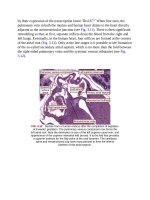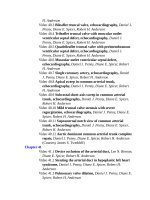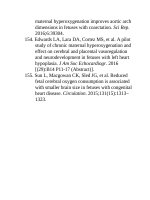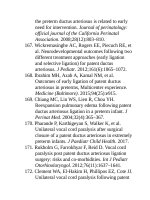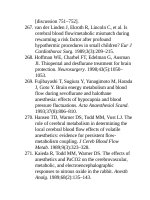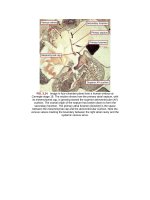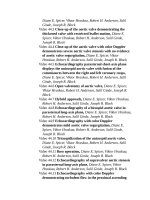Andersons pediatric cardiology 1086
Bạn đang xem bản rút gọn của tài liệu. Xem và tải ngay bản đầy đủ của tài liệu tại đây (87.47 KB, 3 trang )
examplesofductalaneurysms,especiallythoseoccurringpostoperatively.Inthe
caseoftheclinicallysilentandnonhypertensiveduct,littleevidenceexiststhat
itspresenceisanendarteritisrisk,relativetoitsanticipatedhighincidence(0.5%
to1%),46,70,86despiteseveralcasereportsdocumentingitsoccurrence.87–91
PulmonaryHypertensionandthePersistent
Duct
Althoughthepulmonaryarterialpressureisusuallynormaloronlyslightly
elevatedinpatientswithpersistentlypatentducts,occasionallyitisraised
sufficientlytomodifythephysicalfindings.Theimplicationsofpulmonary
hypertensionsecondarytoanincreasedflow,asopposedtothatcausedby
increasedresistance,aremarkedlydifferent,andthetwosituationsshouldbe
clearlydifferentiated.
Whentheductiswidelypatentandpulmonaryvascularresistanceislow,
systolicpulmonaryarterialpressureequalssystemicsystolicpressureandblood
flowtothelungsisseveraltimesgreaterthanthatinthesystemiccircuit.The
pulmonaryarterialdiastolicpressuremayequalorbeslightlylowerthanthatin
theaorta.Thesepatientsusuallyexperienceseverecongestiveheartfailure,with
failuretothriveandrecurrentrespiratoryinfections.Theirelectrocardiogram
showscombinedventricularhypertrophy,andthechestradiographreveals
cardiomegalywithmarkedpulmonaryplethora.Theechocardiogramwillreveal
enlargementoftheleftheartchambers.Suchpatientsrespondpoorlytomedical
therapy,andthecorrectmanagementistoeliminatetheshunt.Successful
ligationorcatheterocclusionusuallyrestorespulmonaryarterialpressureto
normal.Thereappearstobelittleriskofsubsequentpulmonaryvascularchanges
inthisgroupofpatients.
Someindividualsrespondtopulmonaryvenousdistension,andtotheleft
atrialenlargementsecondarytohighpulmonarybloodflowbecauseofreflex
pulmonaryvasoconstrictionpartiallyprotectingthemselvesagainstthefull
effectsofunrestrictedductalflow.Ifstudiedhemodynamically,thesepatients
willbefoundtohaveamoderateleft-to-rightshunt,withpressureinthe
pulmonarycirculationatsystemiclevels,withorwithoutahighpulmonary
capillarywedgepressure.Pulmonaryarterialpressureusuallyfallswith
administrationofoxygenorinresponsetopulmonaryvasodilators.Successful
eliminationoftheshuntusuallyrestorespulmonaryarterialpressuretonormal.
Fixedandhighpulmonaryvascularresistancemayresultfromprogressive
structuralchangesinpatientswhooriginallyhavelargeleft-to-rightshuntsand
normalpulmonaryvessels.Alternatively,itmayexistfrombirth.92,93Civenand
Edwards94suggestedthatpatientsinthiscategoryrepresentaformof
persistenceofthefetalpulmonarycirculation.Asyet,thereispoor
understandingofthefactors,whichinitiateandmaintaintheprogressive
pulmonaryvasculardamage.
Itisinstructivetofollowtheclinicalchangesthataccompanytherisein
pulmonaryvascularresistance.Initially,thepulmonarydiastolicpressure
approachessystemiclevels,decreasingdiastolicflowacrosstheduct.Asflow
diminishes,thediastoliccomponentofthecontinuousmurmurbecomes
attenuatedandeventuallydisappears.Atthisstagethepatienthasapansystolic
murmur.Withafurtherincreaseinresistance,systolicpressuresbeginto
equalize,systolicflowdiminishes,thesystolicmurmurshortens,andeventually
italsodisappears.Concurrentwiththesechanges,thesecondsoundbecomes
closelysplitorevensingleandthereisaccentuationofthepulmonary
component.Theclinicalfindingsbecomethoseofseverepulmonary
hypertension,withmarkedrightventricularhypertrophyandaloud,often
palpablesecondpulmonarysound;apulmonaryejectionclickisalmostalways
audible.Thesecondsoundisloudanddifficulttosplit.Ahigh-pitchedearly
diastolicmurmur,theGrahamSteelmurmurofpulmonaryregurgitation,maybe
addedtothesesounds,asmayapansystolicmurmuroftricuspidregurgitation
whenrightheartfailuresupervenes.Equalizationofpressureswithbalanced
resistancesalsobringsreversalofthedirectionofflowthroughtheduct;the
magnitudeoftheflowincreasesconcomitantwiththeriseinpulmonaryvascular
resistance.Insomepatients,itispossibletorecognizedifferentialcyanosis,the
bluediscolorationbeingconfinedtothelowerbody,andwithclubbingofthe
toesbutnotthefingers.Unlessthereisdifferentialcyanosis,itisnotpossibleto
recognizeaductclinicallyinpatientswithseverepulmonaryhypertensionand
highpulmonaryvascularresistance.Thediagnosiswilldependoncardiac
catheterizationandangiography,orcross-sectionalechocardiographyandcolor
flowDopplerstudies.
Untilheartfailuredevelops,thechestradiographshows,atmost,mild
cardiomegaly,withmarkedprominenceofthepulmonaryarterialsegment(see
Fig.41.11,left).Rightaxisdeviation,rightatrialhypertrophy,andright
ventricularenlargementareusuallyevidentintheelectrocardiogram.However,
insomecasesapictureofcombined,orevenleft,ventricularhypertrophymay
stillbeseen.Itisimpossibletocalculateaccuratelytheriskofprogressive
pulmonaryvasculardiseaseinpatientswithalargepersistentduct.Surgical
treatmenthasbeenavailablealmostaslongasclinicalrecognition.The
informationintermsofnaturalhistorynecessarytoanswerthequestionisnot
available,norwouldsuchastudynowbefeasible.Campbell75didnotaddress
thisprobleminhiscalculations,althoughthereareseveralreportsinthe
literatureconcerningthiscomplication.95–97However,thesearebasedon
selectedgroupsofpatientsandoveremphasizethefrequencyoftheproblem.Nor
dotheyalldistinguishadequatelybetweenpulmonaryhypertensionwithhigh
flowandtruepulmonaryvasculardisease.Thepresenceofpulmonary
hypertensionsecondarytostructuralchangeswithinthepulmonaryvasculature
increasestheriskofclosure,especiallyoncethereisright-to-leftshunting,witha
reportedmortalityinmorethanhalfofasmallgroupofsuchpatients.95The
complicationshouldbelargelyavoidedbyearlyrecognitionandtreatmentofthe
hypertensiveduct.Inpatientswithpulmonaryvascularresistancegreaterthan8
Woodsunitspermetersquare,lungbiopsyhasbeenrecommendedtodetermine
candidacyforclosure,butunfortunatelyitmaynotbefullypredictiveof
outcome.98Suchpatientsmaybehemodynamicallyworseafterclosure,withthe
developmentofsuprasystemicpulmonaryarterialpressure,lowcardiacoutput,
andrightventricularfailure.99,100Patientshavebeendescribedwithsevere
histologicchangesconsistentwithirreversiblepulmonaryvasculardisease,
whichresolvescompletelyafterclosureoftheduct.101Intheoccasionalpatient
whoescapesearlydetection,cardiaccatheterizationwithavasodilatorchallenge
ortemporaryballoonocclusionoftheduct100,102maybeusefulindetermining
theextentofpulmonaryvascularchangesandtheirpotentialforreversal.
AneurysmoftheDuct
Trueaneurysmoftheductisrare.Itmanifestsintwodistinctforms,thefirst
presentsatorshortlyafterbirth,103,104theso-calledspontaneousaneurysmof
infancy(Fig.41.15).105Thesecondformpresentsinchildhoodorlater
life.106,107Recentstudiessuggestthattheincidencemaybeashighas8%.108
Thetrueincidenceremainsunknownbecausethedefinitionisnotpreciseand
manyaneurysmsdetectedbyfetalorneonatalechocardiographyresolve
spontaneously,withoutclinicallyapparentsequels.109Approximately25%of
patientswillhaveanunderlyingdisorder,suchastrisomy21or13,SmithLemli-Opitzsyndrome,typeIVEhlers-Danlossyndrome,orMarfan
